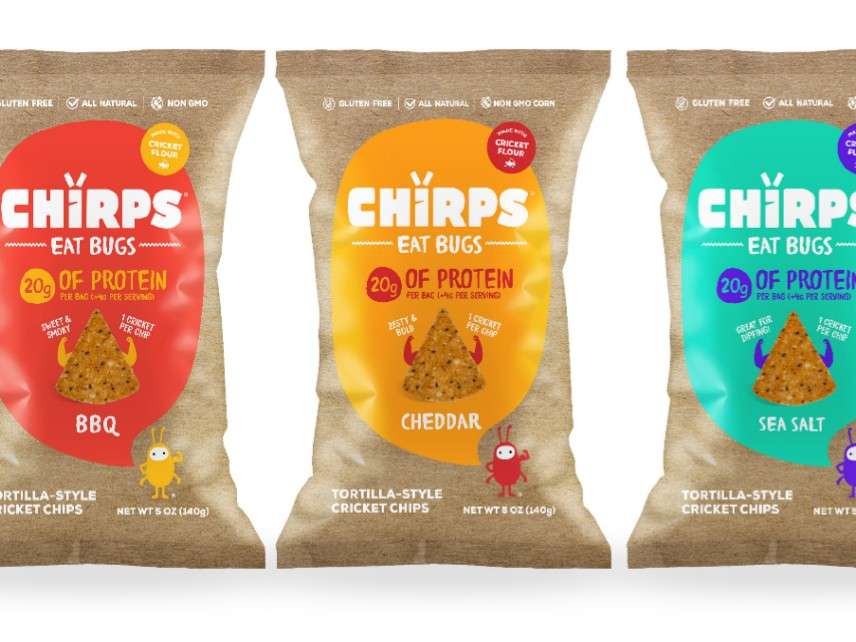Eating Insects Could Be the Future of Culinary Innovation
If government will stay out of the way.

Here in the U.S., we tend not think of insects as food, and are horrified when they turn up in food. Though finding a bug in one's meal is often cause for alarm and disgust, the laws around U.S. food standards recognize that bugs making their way into what we eat is simply a fact of life.
FDA regulations known as the "Food Defect Action Levels" allow certain enumerated amounts and types of insects to be present in many foods. Take frozen orange juice. FDA rules specify that frozen orange juice is acceptable for sale if it contains fewer than "5 or more [fruit fly] and other fly eggs per 250 ml or 1 or more maggots per 250 ml." Canned corn, meanwhile may be sold containing "larvae, cast skins, larval or cast skin fragments of corn ear worms or corn borer," so long as the aggregate length of bug parts does not exceed 12 millimeters in 24 pounds of product. (The rules also discuss the maximum number of rodent hairs various foods may contain.)
But in other parts of the world, people eat insects on purpose. The United Nations calls insects "a highly significant food source for human populations." Another source claims people in 80 percent of all countries—one of every three humans—eat bugs. The things we want to keep out of our food are actually a great source of protein, fat, and fiber.
Yet in a world full of willing bug eaters, it's perhaps no surprise that the law—the thing that so often dictates what we may or may not eat—prevents us from thinking of grubs as grub.
A fascinating piece this week by Massimo Reverberi, founder of a Thailand-based bug-pasta company, suggests a regulatory divide between the English-speaking world, which he says has been welcoming of edible bugs, and the EU, which he reveals "have felt the need to have rules and provide approvals before allowing any marketing."
Reverberi writes that the U.S. and its FDA—the same agency that establishes Food Defect Action Levels for bugs in common foods marketed in the United States—has been surprisingly good about establishing permissive regulations for edible-insect foods.
Others recent news backs that up.
"Last week, the Enterra Feed Corporation, based in British Columbia, was approved by the Association of American Feed Control Officials to sell insect-based [animal] feed in the United States," writes author James McWilliams in a piece this month for Pacific Standard.
While rules in the United States aren't unkind to those who would market bugs, this country nevertheless has been slow to adopt the trend of eating creepy crawlers.
In the early 1990s, while a college student in Washington, D.C., I drank many drinks and ate many bugs as the Insect Club, which, as the name suggests, was not only insect-themed in its décor but also in its bar snacks.
I thought the bug trend might take off then. It didn't. But that's clearly changing.
Safeco Field, home of the Seattle Mariners, began offering toasted chili-lime grasshoppers during games last year. I tried them during a spring game and found them to be a damn tasty beer snack. The grasshoppers proved so popular that Poquito's, the local Mexican restaurant that offers up the grasshoppers, was forced to cap sales.
In addition to grasshoppers, crickets seem a particularly popular offering.
"Crickets are the gateway bug," bug-flour entrepreneur Jarrod Goldin told Fortune in 2016.
San Francisco-based Don Bugito started out as a bug-centric food truck specializing in pre-Hispanic foods of the Americas. It now sells a variety of insect-based foods, including chocolate-covered bugs and cricket-flour granola.
A food truck in Belgium has also capitalized on the "roach coach" insult by selling skewered bugs, dubbed "crickets on a stick."
"They aren't really crickets, they're grasshoppers, but it sounds better to say cricket on a stick," says owner Bart Smit.
Bug sales look set to skyrocket.
"[M]arket research predicts farmed insect production will rise 102 percent between now and 2022," writes McWilliams.
I welcome a future filled with more tasty insect culinary choices. As long as regulators at home and abroad don't erect pointless hurdles along the way, that future seems inevitable.


Show Comments (51)